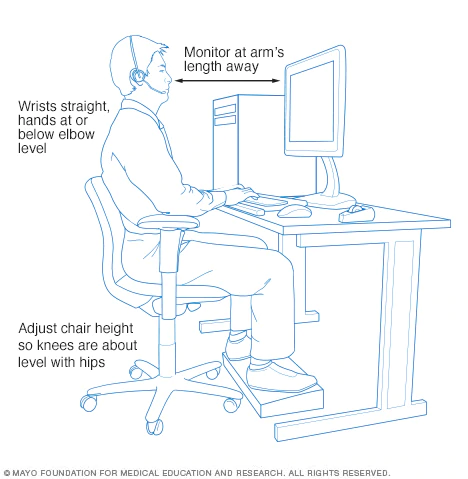
“The key to an ideal workplace, in one hyphenated word, is this: self-awareness.” – Neil Blumenthal
While this sentiment applies to the workplace at large, it can easily be applied to the individual’s own actions and physical environment. And it is most apparent in how a person carries themselves, their physical stance and their posture.
Especially while sitting at the computer at work.
The Digital Plague of the Workplace
While many workers in the U.S. are outdoors or behind counters, the vast majority of American workers are office dwellers. Whether at home or in a workplace, almost 9 out of 10 work at a desk most, if not all, of their work hours.
A blog post at the Money magazine’s website had this to say,
“If you’re like 86 percent of American workers, you sit all day for your job. Add to that the time you spend sitting on the couch after work, watching television, reading, playing games or surfing the Internet, and you spend approximately 13 hours a day sitting down…”
Add to this time spent driving or riding in cars, buses, trains and what have you and you can see how easily we rack up a great deal of “sitting time” every day. The problem, as we’ve noted in previous posts, is that all this sitting and sedentary activity can be – and often is – harmful to our health.
The variety of aches and pains that can result from too much sitting, poor posture while sitting, and the resulting lack of physical movement is troubling.
A column at the Mayo Clinic’s website notes,
“When you sit, you use less energy than you do when you stand or move. Research has linked sitting for long periods of time with a number of health concerns. They include obesity and a cluster of conditions — increased blood pressure, high blood sugar, excess body fat around the waist and abnormal cholesterol levels — that make up metabolic syndrome. Too much sitting overall and prolonged periods of sitting also seem to increase the risk of death from cardiovascular disease and cancer.”
And this is just from the lack of movement. The position of your body and the resulting tendencies for your posture are potentially crippling.
According to one article,
“Neck pain is very common, with nearly one in three individuals affected by it once a year, according to the National Institutes of Health. Women are affected more often than men, and while the symptoms tend to go away on their own, they may recur. Unfortunately, in about 1 in 10 people with recurring neck pain, the pain becomes chronic.
‘Neck pain is a common condition that almost 75% of people experience at some point in life,’ says Paul Christo, MD, associate professor in the Pain Division at Johns Hopkins in Baltimore and host of the Aches and Gains radio show. ‘Women, older adults, and those involved in whiplash injuries from car accidents are at increased risk.’
Neck pain is often related to poor posture, says Allyson Shrikhande, MD, physiatrist and pain management specialist at Lenox Hill Hospital in New York City. ‘When you sit at a computer for eight hours a day, you tend to have poor alignment,’ she says. ‘The poor posture that many people have from sitting like this causes neck pain.’”
As we’ve noted previously on our blog, sitting causes your hip flexors to shorten and your position while seated can also hurt your back, particularly if you have bad posture or don’t use an ergonomic chair. Also, poor posture while sitting can cause compression on the discs in your spine and can lead to premature degeneration, which results in chronic pain.
This is common in the cervical area of the neck and shoulders. The danger is that prolonged compression, or “pinching”, can cause chronic and possibly permanent damage to nerves.
A so-called “pinched nerve” occurs when pressure or force is put on an area of a nerve. This can be from bulging discs or narrowed nerve root openings between vertebrae. Stress and the resulting tension that can center in the shoulder and neck muscles will also tend to entrap nerves while sitting with poor posture for prolonged periods of time.
The warning signals sent by a pinched nerve may cause a few different symptoms in the body, especially in the area around the nerve. Signs and symptoms of a pinched nerve in the cervical area can include:
- Tingling, burning and numbness in the neck, shoulder, arm and hand
- Dull, throbbing pain or stinging pain, such as pins and needles
- muscle weakness or the area may feel it has “fallen asleep”
Prevention and Treatment for “Sitting” Pain
Often people feel that they have a pinched nerve in their shoulder region. This can occur from prolonged sitting and especially prolonged improper posture while sitting. The muscles can become tight and compress the neck area.
However, the nerve is not actually being pinched by a muscle in the shoulder, but comes from the disc area in the neck. It usually happens around C6 and C7 vertebral regions and can result in symptoms like a pinched nerve in the shoulder.
The nerves that run through C6 and C7 vertebrae travel down through your shoulder blades and arms and into your hands and fingers. If they are compressed, or pinched, they can cause chronic pain and muscle spasms in these areas.
By establishing and maintaining ergonomically correct posture, seating, and configuration of your keyboard, mouse and monitor, you can drastically minimize the effects of time sitting at your computer.
In addition, following the rule of standing or walking frequently throughout your workday can alleviate pain and discomfort from sitting.

(image courtesy of Mayo Clinic)
An article at CNN noted that,
“A growing amount of research suggests that just standing — even if you don’t walk around — can have health benefits. To get the right balance, sit 20 minutes out of every half hour at work, standing for eight minutes and moving around for at least two minutes.”
The good news is that if you are already suffering from periodic or chronic neck or shoulder pain caused by working at a desk all day, Pain and Performance Solutions can help.
We often rely on the therapy known as Active Release Technique ®, or ART®, for resolving a pinched nerve in your shoulder. Once this has been decided we start by conducting a physical exam. After a diagnosis has been determined based on your history and our examination, a suitable treatment can be applied. In addition to entrapped nerves, some soft tissue injuries are created by scar tissue, which cannot be detected by a machine or by orthopedic tests, so ART® becomes a diagnostic tool.
We can determine where the adhesions are, and how severe the soft tissue injury is, simply by touch.
ART® is generally performed with a direct contact from us to the patient’s skin. We will find the area to be worked on and either have you actively move a body part or passively move the body part. Our contact coupled with your movements will allow any adhesions to separate.
The entire treatment consists of over 500 specific moves that can be employed and are unique to this therapy technique. These give us the ability to identify and correct the specific problems causing the pinched nerve in your neck and shoulder.
There Is Hope for Relief From Chronic Neck Pain
Active Release Technique® can treat nerve entrapment and, with time and patience on your part, bring relief from pain. Our overall goal is to identify why and how your nerve is compressed and then correct it with as little pain as possible, so you can return to life without fear of it returning.
Contact us now at (707) 636-4404 or use our online booking form to set up a consultation and an office walk through. At the end of the day, we are here for you and to help you achieve a happy and healthy life.